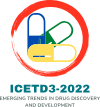Speaker
Description
There is a growing concern with chronic wounds in the modern medical era because they do not heal through the usual phases in an orderly and timely manner. Bacterial colonization of Staphylococcus aureus is one of the major causes of chronic wounds. Generally, the wound healing process can be potentiated by increased angiogenesis. Oxidative stress also influences wound healing as it mediates degranulation and further can exaggerate the inflammation process. ACV exhibits antioxidant, anti-inflammatory, and antimicrobial activity. It has not been widely explored for its therapeutic action as a wound-healing agent. Excessive use of apple cider vinegar can cause some side effects. To reduce the overall dosage of apple cider vinegar, an attempt is being made to study the impact of apple cider vinegar associated with a polyphenolic compound. Experimentally an initial in-vitro study was performed to determine the susceptibility of S. aureus and P. aeruginosa against different dilutions of antibiotic Streptomycin, ACV, p-coumaric acid, ACV + P-coumaric acid were assessed. Also, an in-vitro study for the antioxidant activity of ACV, p-coumaric acid, and ACV + p-coumaric acid was evaluated and the results obtained were satisfactory. Subsequent studies are essential to conclusively show the effect of ACV in association with p- coumaric acid in wound healing which is to be carried out in the ex-ovo system to assess antimicrobial, angiogenic, and antioxidant activity and will be further evaluated along with confirmatory studies in murine models.
